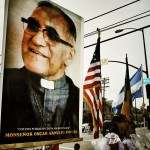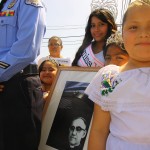Yesterday I spent some time with Salvadoran immigrants as they inaugurated the corner of Pico and Vermont as Monsenor Oscar Romero Square.
An interesting exertion of the ethnic presence in an area where Latinos are the majority population, but the economic power is largely Korean.
These kinds of (I’ll call them) tensions make I think for interesting stories. The square and a hoped-for El Salvadoran Corridor down Vermont was presented to me as a way of having Salvadorans recognized, but also saying to Koreans that Salvadorans are here and to be taken into account.
Salvadorans were stung two years ago when Korean-American leaders tried to expand the official boundaries of Koreatown to include (largely Latino) Pico-Union without consulting them.
It’s unclear how forceful a square or corridor will be — but the precedent of Chinatown, Koreatown, Little Tokyo, Little Armenia, etc. is there. So Salvadorans feel they have something coming, too.
The other interesting point to come out of it, seems to me, is that the Salvadorans pushing this are, for the first time, business owners and Salvadoran-Americans, and mostly younger.
The Salvadoran community took shape in the 1980s amid lots of attention to its civil war. Nonprofits formed here to attend to the needs of the new refugees. The folks who ran these nonprofits became the public face of the Salvadoran community and have been there ever since. The business community was small and disorganized and the political class was nonexistent. (Salvadorans still have elected no one to public office in LA County.) Yet these nonprofit leaders, apparently, often clashed with each other over; occasionally the dividing lines were the same as those during the civil war. Most folks I spoke with count this as a reason why Salvadoran economic and political power has lagged here in L.A.
But that now seems to be changing, as a new generation steps forward, and seems to leave behind the divisions created by the country’s civil war (1980-92). Be interesting to watch how it unfolds.





